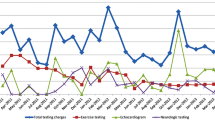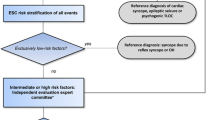Abstract
Our aim was to reduce the frequency of unnecessary testing used by pediatric cardiologists in the evaluation of pediatric patients with syncope or pre-syncopal symptoms without negatively affecting patient outcomes. Guidelines for cardiac testing in pediatric patients with syncope were developed and disseminated to members of our pediatric cardiology division. Educational brochures and water bottles labeled with tips on preventing syncope were made available to families and providers in our clinics. Compliance to the guidelines was tracked and shared with providers. Segmented regression analysis was used to model cardiac testing utilization and guideline compliance by provider over time before and after the implementation of the guidelines. A pre-intervention cohort of 237 patients (June 2014–May 2015) was compared to 880 post-intervention patients (August 2015–June 2019). There was a significant decrease in the utilization of unnecessary tests [odds ratio (OR) 0.3; 95% confidence interval (CI) 0.14, 0.65; p = 0.002] after the intervention. Charges associated with patient evaluation were significantly lower in the post-intervention cohort (interquartile range $0, $1378 vs $0, $213; p = 0.005). Post-intervention visits to emergency departments within our system were significantly decreased, with no change in the incidence of cardiac arrest, hospitalization for syncope, or referral to pediatric electrophysiologists. We demonstrated a significant reduction in the use of unnecessary testing and associated charges by developing guidelines related to the evaluation of pediatric patients with syncope or pre-syncopal symptoms. There was no demonstrable negative impact on patient outcomes.



Similar content being viewed by others
Data Availability
De-identified patient data have been retained to verify all reports within this manuscript.
Abbreviations
- ECG:
-
Electrocardiogram
- CXR:
-
Chest x-ray
- ED:
-
Emergency department
- VVS:
-
Vasovagal syncope
- SD:
-
Standard deviation
- IQR:
-
Interquartile range
- OR:
-
Odds ratio
- CI:
-
Confidence interval
References
Lewis DA, Dhala A (1999) Syncope in the pediatric patient. The cardiologist’s perspective. Pediatr Clin N Am 46:205–219
Sapin SO (2004) Autonomic syncope in pediatrics: a practice-oriented approach to classification, pathophysiology, diagnosis, and management. Clin Pediatr 43:17–23
Zhang Q, Du J, Wang C et al (2009) The diagnostic protocol in children and adolescents with syncope: a multi-centre prospective study. Acta Paediatr 98:879–884
Phelps H, Sachdeva R, Mahle W et al (2016) Syncope best practices: a syncope clinical practice guideline to improve quality. Congenit Heart Dis 11:230–238
Johnson ER, Etheridge SP, Minich LL et al (2014) Practice variation and resource use in the evaluation of pediatric vasovagal syncope: are pediatric cardiologists over-testing? Pediatr Cardiol 35:753–758
Bagnall RD, Weintraub RG, Ingles J et al (2016) A prospective study of sudden cardiac death among children and young adults. N Engl J Med 374:2441–2452
Zhang Q, Zhu L, Wang C et al (2013) Value of history taking in children and adolescents with cardiac syncope. Cardiol Young 23:54–60
Anderson JB, Willis M, Lancaster H et al (2016) The evaluation and management of pediatric syncope. Pediatr Neurol 55:6–13
Redd C, Thomas C, Willis M et al (2017) Cost of unnecessary testing in the evaluation of pediatric syncope. Pediatr Cardiol 38:1115–1122
Ritter S, Tani LY, Etheridge SP et al (2000) What is the yield of screening echocardiography in pediatric syncope? Pediatrics 105:E58
Steinberg LA, Knilans TK (2005) Syncope in children: diagnostic tests have a high cost and low yield. J Pediatr 146:355–358
Kuriachan V, Sheldon RS, Platonov M (2008) Evidence-based treatment for vasovagal syncope. Heart Rhythm 5:1609–1614
Paris Y, Toro-Salazar OH, Gauthier NS et al (2016) Regional implementation of a pediatric cardiology syncope algorithm using standardized clinical assessment and management plans (SCAMPS) methodology. J Am Heart Assoc 5:e002931
Tretter JT, Kavey RE (2013) Distinguishing cardiac syncope from vasovagal syncope in a referral population. J Pediatr 163:1618–1623
Verghese GR, Friedman KG, Rathod RH et al (2012) Resource utilization reduction for evaluation of chest pain in pediatrics using a novel Standardized Clinical Assessment and Management Plan (SCAMP). J Am Heart Assoc. https://doi.org/10.1161/JAHA.111.000349
Magione-Smith R, McGlynn EA, Elliott MN et al (2001) Parent expectations for antibiotics, physician-parent communication, and satisfaction. Arch Pediatr Adolesc Med 155:800–806
Bauchner H, Pelton SI, Klein JO (1999) Parents, physicians, and antibiotic use. Pediatrics 103:395–401
Mangione-Smith R, Zhou C, Robinson JD et al (2015) Communication practices and antibiotic use for acute respiratory tract infections in children. Ann Fam Med 13:221–227
Coffman JM, Cabana MD, Halpin HA, Yelin EH (2008) Effects of asthma education on children’s use of acute care services: a meta-analysis. Pediatrics 121:575–586
Anup D, Patel E (2017) Reduced emergency department utilization by patients with epilepsy using QI methodology. Pediatrics 139:e20152358
Yoffe SJ, Moore RW, Gibson JO et al (2011) A reduction in emergency department use by children from a parent educational intervention. Fam Med 43:106–111
Funding
Statistical support through the University of Utah Study Design and Biostatistics Center for this investigation was supported by the University of Utah Population Health Research (PHR) Foundation, with funding in part from the National Center for Research Resources and the National Center for Advancing Translational Sciences, National Institutes of Health, through Grant UL1TR002538 (formerly 5UL1TR001067-05, 8UL1TR000105 and UL1RR025764).
Author information
Authors and Affiliations
Contributions
MW designed data collection, collected data, drafted the initial manuscript, and reviewed and revised the manuscript. JM coordinated and supervised data collection, designed data analysis, and reviewed and revised the manuscript. LK conceptualized and designed the study and reviewed and revised the manuscript. MP and AW designed data collection and critically reviewed the manuscript for important intellectual content. CZ carried out the analysis and critically reviewed and revised the manuscript. CC conceptualized and designed the study, implemented the guidelines, designed the data collection instruments, collected data, and critically reviewed the manuscript for important intellectual content.
Corresponding author
Ethics declarations
Conflict of interest
All the authors declared that they have no conflict of interest.
Ethical Approval
This quality improvement study was approved and provided exempt status by the University of Utah Institutional Review Board (IRB_00126778) and Primary Children’s Hospital Privacy Board.
Additional information
Publisher's Note
Springer Nature remains neutral with regard to jurisdictional claims in published maps and institutional affiliations.
Rights and permissions
About this article
Cite this article
Winder, M.M., Marietta, J., Kerr, L.M. et al. Reducing Unnecessary Diagnostic Testing in Pediatric Syncope: A Quality Improvement Initiative. Pediatr Cardiol 42, 942–950 (2021). https://doi.org/10.1007/s00246-021-02567-4
Received:
Accepted:
Published:
Issue Date:
DOI: https://doi.org/10.1007/s00246-021-02567-4




